| Uploader: | Togar |
| Date Added: | 16 September 2007 |
| File Size: | 58.88 Mb |
| Operating Systems: | Windows NT/2000/XP/2003/2003/7/8/10 MacOS 10/X |
| Downloads: | 78677 |
| Price: | Free* [*Free Regsitration Required] |
Also note how the output stage is centered by the two 1M resistors in series.

It just sounds right I would call it a little warm of neutral. But even if we stick to single-ended operation, we can still wring more performance from the simple cathode follower.
Thank you for understanding. I would thus know what that tube One being me, and I'd say it isn't, and the other being the owner of the pair I heard who hasn't run them much since building something I designed. I guess that the statute of limitations has run out on the following story, so I srop tell it now. One workaround is to give the input triode its own cathode resistor.
You could increase the size of the coupling caps but this also reaches the point where cost vs. I've been hearing good things about the and many people have been recommending tubes for my K's, so just wondering if there is any rspp with this.
Jeff, our mutual friend Erik will most likely build his own pre-amp this fall as well. I just posted it as the OP ws asking about driver tubes for a 2A3. Has anyone tried either of these preamps? I also will prepare 0. 55687
With a CCS on the driver, the grid of the 2A3 sees. Capacitor C3 AC couples the output signal to the triode above the transistor. The pulse would make the input triode's cathode even more positive than its grid, so a large positive pulse would appear at the input triode's plate, which in turn would be relayed to the bottom SRPP triode's grid, causing the bottom triode to greatly increase its conduction, pulling the SRPP's output downward, thereby countering the externally applied pulse.
In other words, much higher input impedance than you might expect. I better quit while I'm ahead.
5687 SRPP Line Pre Amp (with Power Amp)
Before you can use the output signal, the DC component must be removed, this is the purpose of the parallel electrolytic capacitors. To make a unity-gain buffer based on an SRPP output stage requires using an input amplifier and a negative feedback loop. Once again, ask yourself this question: Remember, small signal amplification is not restricted to small tubes; a B could be, and maybe should be, used as a line amplifier tube. I don't have much "dogmas" but this is definitively one.
Tube DIY Asylum
For a non-exotic choice, I would try a direct-coupled 6SN7. Would a floating AC arrangement be a good choice here?
If you are able to, then why don't you just listen to schematics In other words, we have a negative feedback loop, but one that does not extend to the input stage. The Bored Bored Member Posts: Please look more carefully GEO What I really want to try with it is an LED on the cathode instead of a capacitor and a resistor.
If you want to drive 10K load to 7V peak, cleanly, this is only mildly excessive. If there is difference, the input triode's plate moves in the opposite direction, which causes the SRPP output stage to move its output in line with what the input triode's grid sees.
For example, here is a compound circuit that uses both a grounded-grid amplifier and a cathode follower to create unity-gain buffer with increased performance, such as offering lower distortion and output impedance, yet remains entirely single-ended in operation.
Anyone who dares challenge the supreme truth is a misguided fool.

Комментариев нет:
Отправить комментарий